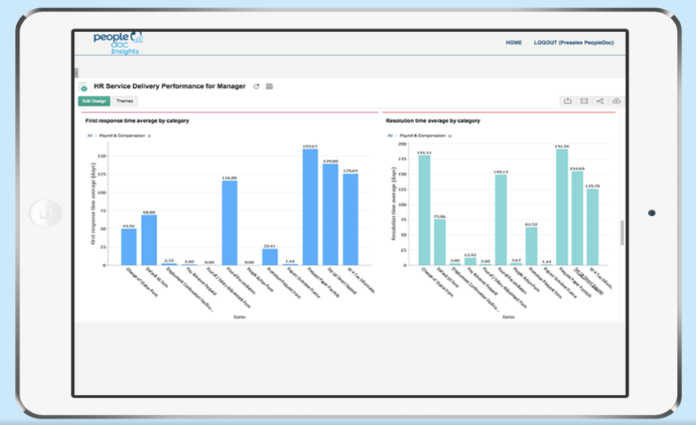
Ensuring a consistent experience across a global organization is one of the most daunting aspects of implementing an enterprise HR services delivery platform. Not only must the needs of thousands, if not hundreds of thousands, of employees be addressed, the requirements of different languages, regulations and local practices must be considered, as well.
Those were the challenges American Express faced when it decided to globalize HR services delivery. Even as it made its processes more consistent and simple to deal with, the company sought to improve HR’s efficiency and increase employee engagement.
Implementing @PeopleDoc_Inc allowed @AmericanExpress to eliminate #HR compartmentalization & offer consistent experience, no matter the location. #HRTech #HRBiz Share on XImplementing PeopleDoc provided the mechanism through which the financial services giant could accomplish these goals, Vice President of Global HRIS Adam Krahling told a recent SHRM webinar. The project allowed Amex to eliminate HR’s compartmentalization and offer leaders a consistent experience, no matter where they’re located. Since the implementation was completed, he said, the company has measured notable increases in both efficiencies and employee engagement.
Speaking with Tim Sackett, president of HRU Technical Resources, Krahling said that even before beginning the initiative, American Express identified four keys to success: flexibility, employee focus, having a strategic technology partner and change management
Flexibility
From the project’s outset, Krahling was guided by the “80/20” rule: He aimed to improve 80 percent of the company’s HR processes while committing 20 percent of the effort to addressing local issues in specific regions.
To accomplish this, the HR team set up global rules and workflows within PeopleDoc. When necessary, it created rules tailored to employees in certain regions. To make this all work, the company needed a technology platform that could accommodate both global and local policies.
That meant doing a lot of work up front, Krahling said. The processes to be managed and the problems to be solved had to be identified before implementation began. Once that was done, putting in place the HR services platform—in this case, PeopleDoc—became a more straightforward effort.
Focus on Employee
Paying attention to worker needs was another critical factor, Krahling said. Today, with consumer technology ubiquitous, employees expect the tools they use at work to be as simple and powerful as the devices they use at home. A system that prioritizes the HR practitioner’s needs over the employee’s is bound to pressure engagement.
Krahling believes that employees, like consumers, have a “24/7” mentality. They want information when they want it, and resist the idea of physically visiting HR to fill out forms. A best practice of global HR service delivery, he said, is to provide a self-service, digital employee experience. In addition, it’s critical for the system to be mobile-friendly, so employees can access information and tools whenever and wherever they want.
Because a simple, smooth experience also encourages adoption and engagement. PeopleDoc’s employee portal provides easy access to information, relevant forms and tools that are personalized by role and region. That lets Amex employees take action when they need to. And, if they have questions that can’t be answered by the system’s knowledge base, they can reach out to HR without having to leave the PeopleDoc environment.
Strong Technology Partner
However, that focus on employees can’t come at the expense of HR. HR needs to monitor compliance and adjust procedures to mitigate risk, for example. Practitioners must be able to monitor what information employees prioritize so they can identify processes that might be simplified. Consequently, American Express wanted a services delivery platform that would allow HR to create new processes or edit existing ones without requiring IT resources. PeopleDoc, Krahling observed, allows his staff to build new forms in less than five minutes.
For a global enterprise like American Express, which has some 60,000 employees in more than 40 countries, a successful HR services delivery platform must be able to scale for world-wide use. Flexibility is also key: HR teams always update information, forms and processes to keep up with changing regulations and policies. And, Krahling said, the ideal platform provider has experience working in multiple countries.
One of American Express’s priorities was the ability to facilitate digital processes and records. Krahling sees paper as being hard to track and manage, while digital records allow processes to be implemented and improved more quickly. Electronic personnel files, for example, have made employee information more accessible and easier to integrate into different processes.
In addition, electronic records are more secure. PeopleDoc provides tools that ensure only authorized people have access to each piece of information.
Change Management
Finally, there’s the challenge of adoption. Implementing the world’s best system accomplishes nothing if both leaders and employees don’t use it. When that happens, the efficiencies gained by deploying a shared services structure quickly diminish.
Krahling’s team knew that. They started laying the groundwork for change well before implementation began. Bringing together stakeholders from across the organization, not only HR, the team briefed them on their plans and listened closely to feedback. As a result, workers throughout the company felt like they were a part of the project from the beginning.
Disclosure: PeopleDoc’s ebook on the American Express implementation is included in our white paper library. You can download it here.
Sign up for our newsletter here.
Image: PeopleDoc














